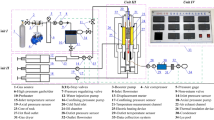Abstract
Geological sequestration of CO2 into depleted hydrocarbon reserviors or saline aquifers presents the enormous potential to reduce greenhouse gas emission from fossil fuels. However, it may give rise to a complicated coupling physical and chemical process. One of the processes is the hydro-mechanical impact of CO2 injection. During the injection project, the increase of pore pressures of storing formations can induce the instability, which finally results in a catastrophic failure of disposal sites. This paper focuses mainly on the role of CO2-saturated water in the fracturing behavior of rocks. To investigate how much the dissolved CO2 can influence the pore pressure change of rocks, acoustic emission (AE) experiments were performed on sandstone and granite samples under triaxial conditions. The main innovation of this paper is to propose a time dependent porosity method to simulate the abrupt failure process, which is observed in the laboratory and induced by the pore pressure change due to the volume dilatancy of rocks, using a finite element scheme associated with two-phase characteristics. The results successfully explained the phenomena obtained in the physical experiments.











Similar content being viewed by others
References
Bear J (1972) Dynamics of fluids in porous media. Dover, New York
Genuchten V (1980) A closed form of the equation for predicting the hydraulic conductivity of unsaturated soils. Soil Sci Am Soc 44:892–898
Lei XL, Kusunose K, Rao MVMS, Nishizawa O, Satoh T (2000) Quasi-static fault growth and cracking in homogeneous brittle rock under triaxial compression using acoustic emission monitoring. J Geophys Res 105(B3):6127–6139
Lei XL, Nishizawa O, Xue Z (2003) Experimental study on the fractures of sandstone and andesite during injection of CO2-saturated water by monitoring acoustic emission and velocity. Abstracts of EGS-AGU-EUG Joint Assembly 2003, Nice, France
Li Q, Wu ZS, Li XC, Ohsumi T, Koide H (2002) Numerical simulation on crust deformation due to CO2 sequestration in deep aquifers. J Appl Mech (JSCE) 5:591–600
National Astronomical Observatory (2004) Rika Nenpyo (Chronological Scientific Tables 2005). Maruzen Co. Ltd., Tokyo
Satoh T, Nishizawa O (1997) A high speed, multi-channel waveform recording system for AE measurement (in Japanese with English abstract). Bull Geol Surv Jpn 48:439–446
Socolow RH (2005) Can we bury global warming? Sci Am 293(1):49–55
Zhang DX (2001) Stochastic methods for flow in porous media: coping with uncertainties. Academic, London
Acknowledgment
This work was partially supported by the Joint Earthquake Science Foundation of China under Contract No.104146.
Author information
Authors and Affiliations
Corresponding author
Rights and permissions
About this article
Cite this article
Li, Q., Wu, Z., Lei, Xl. et al. Experimental and numerical study on the fracture of rocks during injection of CO2-saturated water. Environ Geol 51, 1157–1164 (2007). https://doi.org/10.1007/s00254-006-0406-y
Received:
Accepted:
Published:
Issue Date:
DOI: https://doi.org/10.1007/s00254-006-0406-y




